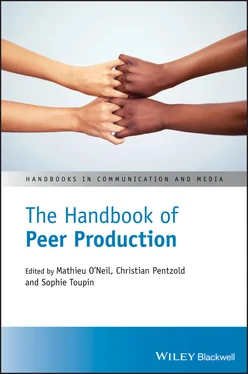68 Pentzold, C. (2018). Grounding peer production in practice: Editorial routines and everyday engagement in the “free encyclopedia anyone can edit.” Communication, Culture and Critique, 11(3), 455–474.
69 Reagle, J. (2005). A case of mutual aid: Wikipedia, politeness, and perspective taking, Wikimania 2005, Frankfurt, Germany.
70 Riehle, D., Riemer, P., Kolassa, C., & Schmidt, M. (2014). Paid vs. volunteer work in open source. 47th Hawaii International Conference on System Sciences (HICSS). Waikoloa, HI. (pp. 3286–3295). doi:10.1109/HICSS.2014.407.
71 Robinson, C. J. ([1980]2000). Black Marxism: The making of the Black radical tradition. Chapel Hill, NC: University of North Carolina Press.
72 Rothschild‐Whitt, J. (1979). The collectivist organization: An alternative to rational–bureaucratic models. American Sociological Review, 44, 509–527.
73 Schöpf, S. (2015). The commodification of the couch: A dialectical analysis of hospitality exchange platforms. tripleC, 13(1), 11–34.
74 Söderberg, J., & O’Neil, M. (2014). Introduction. In J. Soderbergh & Maxigas (Eds.), Book of peer production (pp. 2–3). Göteborg: NSU Press. Retrieved from http://peerproduction.net/projects/books/book‐of‐peer‐production/
75 Spek, S., Postma, E., & van den Herik, J. (2006). Wikipedia: Organisation from a bottom‐up approach, WikiSym 2006, Odense, Denmark (August).
76 Srnicek, N., & Williams, A. (2016). Inventing the future: Postcapitalism and a world without work. London: Verso.
77 Stallman, R. M. (1985). The GNU manifesto. Retrieved from www.gnu.org/gnu/manifesto.en.html
78 Terranova, T. (2000). Free labor: Producing culture for the digital economy. Social Text, 18(2), 33–58.
79 Turner, F. (2006). From counterculture to cyberculture. Stewart Brand, the Whole Earth Network, and the rise of digital utopianism. Chicago: University of Chicago Press.
80 van Dijck, J. (2013). The culture of connectivity: A critical history of social media. Oxford: Oxford University Press.
81 Varian, H. (2010). Computer mediated transactions. American Economic Review: Papers & Proceedings, 100, 1–10.
82 Verrips, J., & Meyer, B. (2001). Kwaku’s car: The struggles and stories of a Ghanaian long‐distance taxi driver. In D. Miller (Ed.), Car cultures (pp. 153–184). Oxford: Berg.
83 Wark, M. (2004). A hacker manifesto. Cambridge, MA: Harvard University Press.
84 Weber, M. (1947). The theory of social and economic organization. New York, NY: Free Press.
1 1The advent of commons‐based peer production in the late 1990s is the outcome of overlapping historical, social, economic, and technological factors, including, but not limited to: (a) the traditional self‐management of common‐pool resources identified by Elinor Ostrom. The bulk of Ostrom’s work was applicable to finite natural resources (such as fish stocks in a river) administered by a local community. Such rival resources raise issues linked to their long‐time preservation; in contrast digital commons raise issues concerning their production and enrichment (Coriat, 2011); (b) the notion that sharing knowledge freely, alongside universalism, disinterestedness, organized skepticism, and communism (later changed to communalism) are the foundations of science: “The communism of the scientific ethos,” wrote Robert Merton, “is incompatible with the definition of technology as ‘private property’ in a capitalistic economy” (1942: 275); (c) the principle of peer review which holds that correctness is more likely to emerge if a statement, or an elegant solution to a technical problem (a.k.a. “hack”) is submitted to the scrutiny of a community of peers of equal competence; (d) the uniquely contradictory historical moment during which the Internet was created (the late 1960s): the Cold War threat of nuclear conflict between the two superpowers led to the US military’s request for a distributed network where digital packets could autonomously re‐route around destroyed nodes, so intelligence and control were located at the edges, where packets are disassembled and reassembled, not in a central hub as in a traditional phone exchange (Baran, 1964); this was also the height of the counterculture, with its distrust of traditional authorities and emphasis on personal liberation, a belief that would evolve into diverse branches, one of which was the notion that personal computers represented the means to establish free communications and new types of virtual communities (Turner, 2006). Internet technical protocols were established by organizations such as the Internet Engineering Task Force; IETF “hackers” were computer engineers and students influenced by the counterculture, and therefore resistant to hierarchy. The IETF adopted a non‐authoritarian methodology to propose improvements to Internet protocols: RFCs (request for comments) were released electronically, so that innovation was not based on the imposition of authority, but on appeals to a community of peers for input (O’Neil, 2009). The founding belief of the IETF was that the legitimate basis for authority was autonomous technical excellence: “We reject kings, presidents and voting. We believe in rough consensus and running code,” said Internet pioneer David Clark (Hoffman & Harris, 2009); (e) the UNIX computer system, which Minix and subsequently Linux were modeled on, has a modular structure, signifying that as long as common protocols were respected, new components could be added independently; more generally the Internet and the Web are classic examples of “combinatorial innovation” (Varian, 2010); (f) the rise of personal computers as consumer items and attendant increased proprietary enclosures around software in the 1980s led MIT computer scientist Richard Stallman to declare that he would “put together a sufficient body of free software so that I will be able to get along without any software that is not free” (Stallman, 1985), and to create the GNU operating system, the General Public License or “copyleft,” and the Free Software Foundation. Whilst Stallman’s continued advocacy for the right to freely access and modify code in order to improve it has proved an inspiration for many, he sadly demonstrated in 2019 a lamentable insensitivity to sexism (Musil, 2019); (g) finally the emergence of the mass Internet in the early 1990s facilitated the rapid global dissemination of computer code (instead of exchanging diskettes by post), leading to the advent of Linux, and in the 2000s of the writeable Internet (“Web 2.0”) including wikis, weblogs, and social networking sites.
2 2 https://guifi.net/
3 3 https://berlin.freifunk.net/
4 4 https://briarproject.org/
5 5 www.memoryoftheworld.org/
6 6 https://libgen.is/
7 7 https://monoskop.org/Monoskop
8 8 https://preciousplastic.com/
Part II Concepts: Explaining Peer Production
2 Grammar of Peer Production
Vasilis Kostakis and Michel Bauwens
In 2005, Michel Bauwens published “The Political Economy of Peer Production.” In this seminal article he discussed the principles, characteristics, basic structures, and the future of the then nascent ecosystem of peer production. I (Vasilis) stumbled upon this article, and upon Michel, in 2007 as a postgraduate student at the University of Amsterdam. “The Political Economy of Peer Production,” along with Yochai Benkler’s work, have had a major impact on my understanding of peer production. Benkler had first observed the seeds of an emerging mode of production in his 2002 article “Coase’s Penguin, or, Linux and ‘The Nature of the Firm’.” He provided the vocabulary for a new field of scholarship. Three years later, building on Benkler’s work, Michel developed these insights in his article.
Читать дальше


![О Генри - Справочник Гименея [The Handbook of Hymen]](/books/407356/o-genri-spravochnik-gimeneya-the-handbook-of-hymen-thumb.webp)









